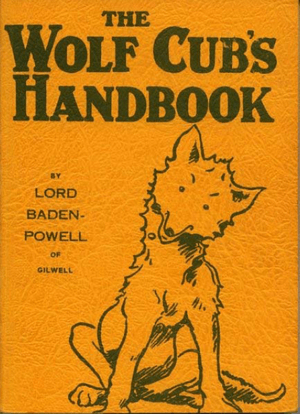The Wolf Cub's Handbook facts for kids

Post-1929 edition cover
|
|
| Author | Robert Baden-Powell |
|---|---|
| Illustrator | Robert Baden-Powell |
| Country | United Kingdom |
| Language | English |
| Genre | Children's literature |
| Publisher | C. Arthur Pearson Limited, London |
|
Publication date
|
1916 |
The Wolf Cub's Handbook is a special book that teaches young people about the Wolf Cubs program. It was first published in December 1916. The first versions of the book were written and illustrated by Robert Baden-Powell, who also started the Scouting movement. Later versions of the book were updated by other writers.
The book's theme is based on the famous stories from Rudyard Kipling's The Jungle Book. This means it uses characters and settings from the jungle to make learning fun!
Contents
How the Wolf Cub's Handbook Started
In 1914, the Boy Scouts Association in the United Kingdom wanted a program for younger boys. These boys were usually too young to join the main Boy Scouts, who were around 11 years old. So, they asked a person named Percy Everett to create a plan for these younger boys.
Percy Everett's idea was called "Junior Scouts." But Baden-Powell had a different vision. He didn't want a simple, smaller version of the Boy Scouts. He believed the younger program should have its own unique name, uniform, and activities.
Baden-Powell's Vision for Wolf Cubs
In 1916, Baden-Powell shared his own ideas for this new program. He decided to call it the Wolf Cubs. He kept some of Everett's ideas but added a special theme. This theme came from Rudyard Kipling's Jungle Book, which was published in 1894 and was already very popular with children.
The Wolf Cubs program was officially launched on June 24, 1916, in Westminster, London. Soon after, Baden-Powell wrote The Wolf Cub's Handbook, which came out in December 1916.
What's Inside the Handbook?
The book included short summaries of the Mowgli stories. It also had ceremonies and games inspired by the jungle theme. Mixed in with these fun parts were important lessons. These lessons taught about health, staying fit, camping, observing nature, tying knots, using semaphore (a way to send messages with flags), first aid, knitting, and how to be helpful at home.
The chapters in the book are called "bites." This is because, as the book says, "this book is a meal offered by an old Wolf to the young Cubs."
The very first edition of the handbook didn't have details about badges or tests. But later in 1916, Baden-Powell met Vera Barclay. She was a young leader in the Scout Movement. Vera Barclay and Baden-Powell worked together to create the details for the Wolf Cub training program, including the badges and tests. These were then added to the second edition of the book.
Baden-Powell and Rudyard Kipling

Baden-Powell sent the early copies of his new book to Rudyard Kipling on July 28, 1916. He wanted Kipling's permission to use parts of The Jungle Book. Kipling approved the book without making any changes.
Kipling and Baden-Powell had actually met before, in India, back in the 1880s. Because of his connection to the Wolf Cubs, Kipling was later given an honorary title: Commissioner of Wolf Cubs.
The Handbook's Impact
The Wolf Cub's Handbook became the official book for The Boy Scouts Association's Wolf Cubs program. It was translated into many different languages so Cubs all over the world could use it.
In the United States, the Boy Scouts of America got the rights to publish their own version of the book in 1918. However, they didn't officially start their own Cub Scouts program until 1930, and they used a slightly different plan.
The Wolf Cub's Handbook, with its many updated versions, remained the official book for Wolf Cubs for a long time. This continued until 1966, when a report called The Chief Scout's Advance Party Report suggested some changes. This report recommended putting less focus on The Jungle Book theme. After that, the Wolf Cubs program was simply renamed "Cubs."

